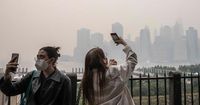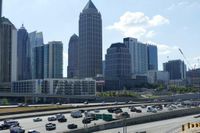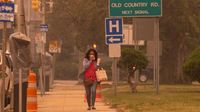On April 23, 2025, the American Lung Association released its annual "State of the Air" report, revealing a troubling rise in air pollution across the United States, with nearly half of the population exposed to unhealthy levels of ozone and particulate matter. The report highlights that approximately 156 million Americans live in areas that received an "F" grade for at least one measure of air quality, marking a significant increase of 25 million people compared to the previous year.
The report analyzed air quality data from 2021 to 2023, a period that included one of the worst wildfire seasons on record in Canada. This contributed to a sharp increase in air pollution levels, particularly affecting communities in the Midwest and Northeast. Harold Wimmer, President and CEO of the American Lung Association, stated, "Families across the U.S. are dealing with the health impacts of air pollution every day, and extreme heat and wildfires are making it worse." He emphasized that air pollution is linked to severe health issues, including asthma attacks and low birth weight in infants.
Among the key findings, the report noted that 125 million people, or 37% of the U.S. population, live in areas with unhealthy levels of ozone pollution, an increase of nearly 25 million from the previous year. The report also found that 77.2 million individuals lived in counties that experienced unhealthy short-term spikes in particle pollution, the highest number recorded in the last 16 years. The report highlights that ozone pollution can cause respiratory issues, likening its effects to a "sunburn of the lungs." Inhaling ozone can lead to coughing, shortness of breath, and asthma attacks.
Furthermore, the report indicates that people of color are disproportionately affected by air pollution. A person of color in the U.S. is more than twice as likely as a white individual to live in a community with failing grades for all three pollution measures. Hispanic individuals are nearly three times as likely to live in such areas. Regan Patterson, an environmental engineer and researcher, pointed out the critical need for policy changes to address these disparities.
In Georgia, the American Lung Association's report gave Atlanta a failing grade for both ozone and particle pollution, ranking it third worst in the Southeast for ozone pollution and fourth worst for year-round particle pollution. Atlanta’s air quality has deteriorated, with the city recording 5.5 unhealthy days per year for ground-level ozone, a significant increase from 1.8 days in the previous report. Danna Thompson, advocacy director for the Lung Association in Georgia, stressed the importance of reducing emissions and encouraged commuters to consider alternative transportation methods to mitigate air pollution.
Despite the alarming findings, the Atlanta Regional Commission reported a significant reduction in air pollution emissions since 2010, attributing this progress to various initiatives. However, concerns remain about potential rollbacks to Clean Air Act regulations under the Trump administration, which recently granted exemptions to power plants, allowing them to bypass federal emission regulations for mercury and other pollutants.
In Suffolk County, New York, the report revealed a mixed picture. The area received an "A" rating for having no days with high particle pollution but an "F" for 29 days with high ozone levels. Queens, however, earned failing grades in both categories, with 18 high ozone days and seven high particle pollution days. The report noted that wildfires have significantly impacted air quality in the region, causing hazardous conditions and prompting health warnings.
Advocates for clean air policies are increasingly concerned about the implications of funding cuts and regulatory rollbacks at the EPA. Elizabeth Hensil, director of advocacy in West Virginia for the American Lung Association, emphasized the need for continued monitoring and enforcement of air quality standards to protect public health.
In the Wheeling-Ohio metro region, air quality has also declined, with the area ranking as the 130th most polluted in the nation for ozone pollution and 77th worst for year-round particle pollution. Advocates are urging local and federal officials to take action to improve air quality and protect vulnerable populations, particularly children and the elderly, who are at greater risk from air pollution.
Overall, the 2025 "State of the Air" report paints a stark picture of air quality in the U.S. The need for robust air quality monitoring and enforcement of regulations is more critical than ever, especially in light of the increasing frequency and intensity of wildfires and other climate-related events. The American Lung Association calls on everyone to support and defend the EPA to ensure that clean air remains a priority for all Americans.







